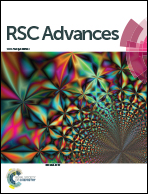Atorvastatin calcium loaded PCL nanoparticles: development, optimization, in vitro and in vivo assessments†
Abstract
The aim of the present study was to prepare atorvastatin calcium (ATR) loaded poly(ε-caprolactone) nanoparticles (ALPNs) to enhance the oral bioavailability, efficacy and safety profile of drug. ALPNs were prepared by a nanoprecipitation technique while formulation and process parameters were optimized using a central composite factorial design. The optimized ALPNs were investigated through in vitro (solid state characterization, morphological, drug release study and stability study) analysis and in vivo (pharmacokinetic, efficacy and safety study) behaviour in rats. The optimized ALPNs having 197 ± 5 nm particle size, 0.213 ± 0.012 polydispersity index and 75.6 ± 3.2% entrapment efficiency, did not exhibit any physicochemical interaction of the drug with the carrier. The X-ray diffraction, differential scanning calorimetry and electron diffraction pattern has substantiated the amorphous character of ATR encapsulated in nanoparticles. The smooth and homogeneous spherical shape of the nanoparticles was evidenced in morphological analyses. The in vitro drug release profile of ALPNs showed a 96 h sustained release and the pharmacokinetic profile in rats exhibited significant enhancement in bioavailability, Cmax and mean resident time of the drug. ALPNs exhibited similar efficacy (plasma lipid profile and glucose level) and markedly improved biochemical safety profiles (creatinine, blood urea nitrogen, creatinine kinase, lactate dehydrogenase and aspartate amino transferase) of rat plasma at a 50% reduced dose compared to orally administered ATR.


 Please wait while we load your content...
Please wait while we load your content...